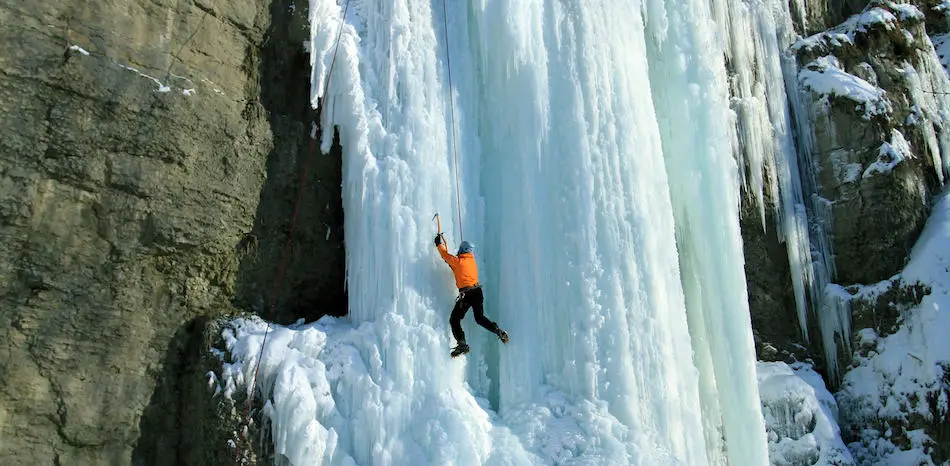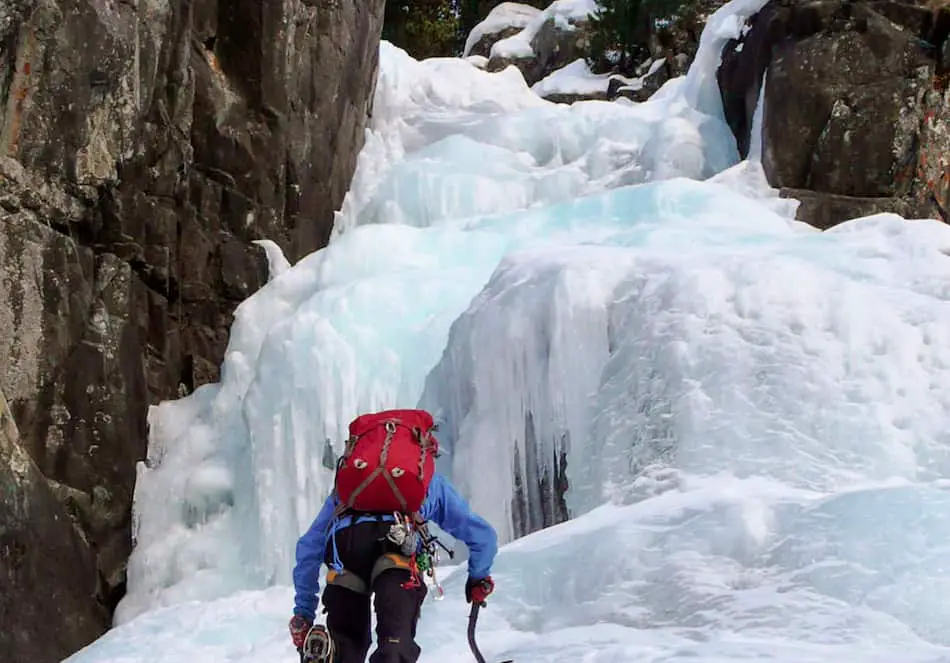
As someone who cares about fitness, it’s important to me that my hobbies help me stay in shape. I did some research to see what the health benefits of ice climbing were.
So, if ice climbing a good workout? Yes, ice climbing is a good workout. It involves several major muscle groups and will burn between 100-1500 calories.
The fitness benefits of ice climbing come from several sources. Obviously, the climbing itself is a physically demanding activity that activates several muscle groups including your arms, quads, and core. There is also a large stamina component involved, as you will likely be on the ice for up to ten minutes at a time. More than that, though, the extra activities surrounding ice climbing also contribute to your fitness: the approach can involve hiking several kilometers with a heavy bag, and even standing in the cold can help burn calories.
Ice Climbing as a Workout
Ice climbing is a full-body workout that utilizes several key muscle groups and is almost guaranteed to leave you sore the next day. There are two main components that I want to look at to truly understand how good of exercise ice climbing is:
- Strength: Strength is the force required to keep you in place and pull your body up the sheet of ice. From constantly griping your ice tools to using your core to keep your balance, ice climbing requires high degrees of strength.
- Cardio: There are two types of cardio to look at: short-term and long-term. Short-term works your anaerobic muscles (think sprinting), whereas long-term cardio looks at your aerobic capabilities (think jogging). Both are required for ice climbing.
One of the great things about ice climbing is that you’re not just getting a workout in the moments when you’re on the wall. As I mentioned, there are other things that need to be considered when you try to quantify the workout the ice climbing provides. You’re on your feet for eight hours at a time, hauling heavy packs of gear from one climb to the next. This provides a workout in its own.
Strength

First, let’s talk about the strength workout that ice climbing gives you. Any activity that causes your muscles to strain and then heal is going to help build up strength, as the muscle will heal over stronger than they were originally.
In this way, the motions you go through while ice climbing help build up strength in multiple different body parts. Let’s look at each of them individually.
Forearms
Your forearms are maybe the muscle that’s going to get worked the most when you’re ice climbing. The effort that it takes to hang your bodyweight from your axes for minutes at a time is absolutely exhausting, especially because this is a motion that many people are not used to. Even seasoned rock climbers may find their forearms getting pumped out when ice climbing.
This strength will obviously help you become a better ice climber, but it also has some extraneous benefits. If you’re also into climbing, you might find that your endurance increases substantially once you start mixing some ice in. Other sports that require grip strength, such as body building, will also benefit from this.
Upper Body
Aside from your forearms, there are several other upper body muscle groups that benefit from ice climbing. First and foremost are your shoulders, which you use to lift the axe above your head and swing it into the rock. This motion, repeated tens or hundreds of times throughout the day, builds up shoulder muscle and also helps with mobility.
Your back will also get a good workout in, as you use it to pull yourself up by your axes. Now, good ice climbers will tell you that you want to use your back as little as possible— your forearms and legs should be doing most of the work— but most people are still going to find that they’re using their back to hold them up.
Core
Although it won’t torch your abs like a good bouldering session will, ice climbing is still going to give you a pretty decent core workout.
Your abs help keep you balanced while on the ice, ensuring that your weight doesn’t go too far in any one direction (which could cause a fall). You also activate some core muscles when you bring your legs up into a proper kicking position.
Legs
Beside your forearms, your legs are probably the muscle that’s most likely to be sore after a good ice climbing session.
Specifically, I’m speaking about your calves, which are going to get getting a whole lot of work trying to keep you in position on the wall. With only the tips of your crampons driven into the ice, you rely on your calves to hold your bodyweight up while you’re climbing. This means that they’re activated for nearly the entire duration of a pitch.
Furthermore, the rest of your legs also get a pretty good workout pushing you from a squatted kicking position into a standing swinging position. This action, repeated tens of times over the duration on a climb, activates your quads and glutes.
Cardio

Now that we’ve gone over the different muscle groups that get worked when ice climbing, let’s talk about the cardio component of the activity.
As I said, all of the above activities will build aerobic (short-term) strength in the muscle groups mentioned. Some of them (like forearms and calves) are under consistent enough strain to also start to build anaerobic strength.
There’s another component to the workout, though: the full body strength that you develop after spending a day walking, climbing, belaying, and hauling gear. Especially if you’re on a climb with a long approach, you’re going to be spending lots of time performing mild-to-moderately strenuous activity. This helps builds up anaerobic strength in your legs and lungs, and your overall fitness will increase.
How Many Calories Do You Burn Ice Climbing?
This is a tricky question to answer, because burning calories is difficult to calculate and I don’t have the medical equipment required to get an exact answer. There is, however, some information out there, and I’m going to use it to make a (scientifically based) guess.
Firstly, there ae two main activities that would burn calories when ice climbing:
- The physical strain of completing a pitch, along with all of the extraneous activities (hiking in, rappelling, etc.)
- The natural calories that your body burns while standing outside in the cold
There’s very little (see: none) actually data on how many calories you burn ice climbing, so for the purpose of this article I’m going to use rock climbing data as a proxy. As someone who’s done both activities, I feel comfortable saying that ice climbing is equally (if not more) physically demanding than rock climbing.
So, how many calories do you burn while rock climbing? According to this study, a normal person can burn between eight and ten calories per minute while rock climbing. Say that a normal ice climb takes about ten minutes, and you can conclude that you’ll burn about 100 calories per route that you climb.
There are other factors that will play into this, as well. Less experiences climbers are likely to burn more calories for two main reasons:
- Their form is worse, meaning that they need to expend more energy to make up for it.
- The fear/nerves that sometimes accompany new ice climbers can activate your body’s fight-or-flight response and cause you to burn more calories than you normally would.
All things considered, though, it’s fair to say that you’ll burn about 100 calories per route. If you climb 5 routes in a day, that’s 500 calories burned— a pretty good workout in its own.
That doesn’t account for the fact that you burn huge amounts of calories standing out in the cold, however. This report states that shivering for an hour will burn about 400 calories. Now, if you have a proper layering system, you shouldn’t constantly be shivering (in fact, this would probably be bad). So, while you won’t be burning 400 calories an hour just standing around in the cold, it’s probably pretty fair to think that you’ll burn 150-200.
That claim is backed by this study, which found that being outside for a full day in cold weather can burn about 1000 extra calories on top of your daily caloric requirements.
So, overall, a good day of ice climbing will burn 1200-1500 calories when you factor in the exercise as well as the thermoregulation performed by your body.
